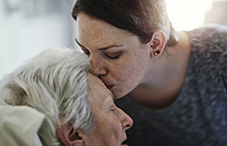

"CE Corner" is a continuing education article offered by the APA Office of CE in Psychology.
To earn CE credit, after you read this article, purchase the online exam at www.apa.org/ed/ce/resources/ce-corner.
Upon successful completion of the test — a score of 75 percent or higher — you can immediately print your CE certificate.
The test fee is $25 for members and $35 for nonmembers. The APA Office of CE in Psychology retains responsibility for the program. For more information, call (800) 374-2721.
CE credits: 1
Learning objectives: After reading this article, CE candidates will be able to:
It's been two decades since Oregon enacted the nation's first Death with Dignity Act, allowing people with terminal illnesses to hasten their deaths by self-administering medications prescribed by a physician. Since then, California, Colorado, Vermont, Washington state and Washington, D.C., have passed similar statutes.

In some ways, the cultural conversation about assisted dying has evolved since Oregon paved the way for physician-assisted death, says Barry Rosenfeld, PhD, a professor of psychology and adjunct professor of law at Fordham University who has studied the desire for hastened death. In the 1990s, the arguments for and against assisted dying "were more emotional than scientific," he says. Today, policymakers and voters have more data to draw from when considering similar legislation.
Yet the topic arouses strong feelings—and raises plenty of questions. Can a person with depression rationally choose to hasten death? Would the option be less appealing if people received better care for physical symptoms and emotional distress? Could aid in dying put marginalized groups at risk?
As physician-assisted dying becomes available in more places, research psychologists are finding opportunities to study people's motivations and the potential benefits and harms of aid in dying. On the clinical side, psychologists' skills are helpful as people sort through their feelings and desires at the end of life, says Elizabeth Goy, PhD, a psychologist at the Portland VA Medical Center and associate professor at Oregon Health and Science University, and chair of the APA Working Group on End-of-Life Issues and Care.
"The very best thing we can do as psychologists is to improve communication and make sure that we are attending to the needs and suffering of patients who are at the end of life," Goy says. "Dying is universal, and it behooves all of us to have some foundational knowledge about end-of-life issues."
Goy and her colleagues on the working group were charged with updating APA's previous resolution on assisted suicide, adopted in 2001. In August, APA's Council of Representatives voted to approve the updated resolution. Like the previous resolution, the 2017 update states that APA neither endorses nor opposes assisted dying at this time.
"It was the consensus of the working group that this is a matter between the psychologist and the person considering aid in dying," says group member and Jonesville, Virginia–based psychologist James L. Werth Jr., PhD. "Psychologists have to be aware of their own biases, and if they can't be a part of the discussion without those biases getting in the way, they should refer the person to someone else. But we determined that APA shouldn't be a limiter of that discussion."
The most notable update to the resolution was linguistic. When the 2001 resolution was passed, the topic was known as "assisted suicide." Today, providers prefer the term "assisted dying" to reflect the distinction between suicide and the process of hastening death to alleviate pain and suffering.
Still, the specter of depression and suicide hangs over public opinion of assisted dying. Since Oregon first raised the possibility of legalized dying in the 1990s, researchers have grappled with the question of whether it can ever be considered a rational choice, Rosenfeld says. "Some people felt that almost everyone who seeks this option is doing so out of a rational appraisal of their situation. Others argued this is just a form of suicide and we should protect them from themselves," he says.
But research in the intervening years has suggested the truth lies in the gray area between, he adds. "Of the people who pursue this option, a sizable portion are rationally appraising their situation. And a sizable proportion are appraising it through a lens of depression."
In a study of terminally ill patients, for instance, Rosenfeld and his colleagues found that desire for death was associated with depression, and that desire decreased in patients who responded to antidepressants ( Psychosomatics , Vol. 51, No. 2, 2010). Other research, however, suggests that depression is not a major driver for most people who request aid in dying. When Oregon's law was passed, Goy teamed up with psychiatrist Linda Ganzini, MD, MPH, at Oregon Health and Science University, to study the moods, values, needs, concerns and symptom burdens of 58 Oregon residents with terminal illnesses who pursued assisted death. They found that most of those people did not have depressive disorders.
However, they also concluded that the Death with Dignity Act, as written, might fail to protect some patients with depression from making the choice to hasten death ( BMJ , Vol. 337, 2008).
Still, some advocates note that depression shouldn't necessarily make a person ineligible for physician-assisted death. "In the normal world of decision-making, we wouldn't say people lose autonomy to make decisions because they're moderately depressed," Rosenfeld says. Indeed, he adds, there's too little research to indicate how a person should feel or act as they approach their final days. "How cheerful should you be when you have a terminal illness?" he asks.
Some proponents of legalized aid in dying suggest that the option may be unfairly singled out because of cultural beliefs about the morality of suicide. "Assisted dying gets a lot of attention because of the values and emotions that get brought into it," says Werth. Yet many more people with serious illness end their lives through some other negotiated means, he says, such as ceasing medications, withholding food or drink, refusing life-sustaining treatment or signing "do not resuscitate" orders. "Most people will die those ways," he says.
After two decades of evidence from Oregon, research is answer-ing many questions about aid in dying. That evidence suggests that the desire to hasten death often comes from wanting to maintain some power over one's own life, Goy says. "In our research, the main reason people voiced for wanting the option was that they really wanted to have control over the circumstances of dying."
The wish for control can be for a variety of reasons, they found, including loss of autonomy and function or worries about future pain ( JAMA Internal Medicine , Vol. 169, No. 5, 2009). But reassuringly, when Goy and her colleagues compared people who expressed a desire for aid in dying with others with terminal illness who did not seek that option, they found no indication that the former group was motivated by financial concerns or being a burden to their loved ones, Goy says.

A need for control may also be behind another finding related to assisted dying: Many people who go through the steps to receive a prescription for lethal medication don't ultimately move forward with taking it, points out Veronica L. Shead, PhD, a clinical psychologist who specializes in palliative care at the VA St. Louis Health Care System and a member of the APA working group. In Oregon, for example, 204 people received prescriptions through the Death with Dignity Act in 2016, but only 133 of them died through that means—a proportion similar to that of previous years.
More research is needed to fully understand why and when some people ultimately make that choice, Shead notes. But it may be that just having the option provides a sense of control over the circumstances of one's death, allowing the person to focus on the quality of life that remains rather than fear of future suffering.
Research also shows that the choice to hasten death doesn't negatively impact surviving family members. Months or years after the death of the patients in their study, Goy and Ganzini interviewed their family caregivers. When they compared family members of those who requested aid in dying with those who did not, the researchers found no differences in depression, grief or use of mental health services. In fact, families of people who chose aid in dying reported that they felt more prepared and accepting of their loved one's death ( Journal of Pain and Symptom Management , Vol. 38, No. 6, 2009).
That could be because family discussions of hastened death often force families to discuss difficult topics they might otherwise not have spoken about, suggests Judith Gordon, PhD, a Seattle-based psychologist and clinical professor of psychology at the University of Washington who has studied end-of-life decision-making since 1996. "In this culture, there's still a lot of resistance to talking about dying, even if someone is diagnosed with a terminal disease," she says. "When people want to use this option, they need the support of their doctors and typically also want the support of their families."
Most people who receive a prescription for lethal medication talk to their families about their decision. "One of the gifts when someone makes this choice is that it brings the discussion to the table. The whole family or support group talks not just about this particular way of dying, but about all the issues related to how they feel about the death and what they will do later. It's an enormous benefit," Gordon says.
Despite those potential benefits, critics express concerns about the possible harms of assisted death.
One worry surrounds access. So far, most of the people who have requested aid in dying are white, middle-class and typically well-educated, notes Carol Gill, PhD, APA working group member and professor of disability and human development at the University of Illinois at Chicago. "This sector of the population generally has access to options and seeks control of their life circumstances up to the end of life," she points out. "In contrast, there are underrepresented communities who have very different views of assisted dying."
The biggest concern to Gill and others is that people from disadvantaged groups might consider hastened death because their health-care needs are not being met. There are well-documented disparities in access to health-care services, with people from lower socioeconomic backgrounds, those with lower health literacy, and members of ethnic or racial minorities being less likely to receive adequate care, including palliative care services.
"There are a number of marginalized populations that are legitimately concerned about whether they are getting all of the best options in care at the end of life," Goy says. "We want to be sure we are attentive to treating pain adequately and addressing emotional experiences such as hopelessness, depression and despair, so that assisted dying does not seem like the only option."
Gill says that many in the disability-rights community have expressed unease with aid in dying because of concerns that people won't receive the resources they need to live meaningful lives despite physical limitations. "There are no assisted-dying laws that guarantee those resources, and that feels discriminatory to a lot of people with disabilities," she says.
Indeed, the very idea of "death with dignity" is an affront to many people who have physical limitations that require daily assistance, Gill says. "Some right-to-die activists have written about assisted dying as an antidote for indignity that occurs at the end of life, such as needing help to dress or use the bathroom. If you're a person with functional limitations, that's a real slap in the face," she says.
For most people, including those with disabilities and those facing functional loss at the end of life, social connection is what makes life worth living, she adds. "Having a meaningful life doesn't necessarily mean that life needs to be pain-free or without physical impairment or functional limitations. What it means is to remain engaged humanly, and get enough support from others or technology to engage in the activities that matter, that make life meaningful."
Even advocates of physician-assisted death say it's crucial that researchers continue to explore the process to ensure it's used responsibly. More work is needed to understand how terminally ill people make treatment decisions, Rosenfeld says, including the decision to end one's life. "The fact that assisted-dying laws aren't used that often has made people more confident that the law isn't being misused. But could that number go down a notch further by having more services available? That's where more research could be really informative," he says.
Gill adds that too little is known about how people make the decision to take lethal medication after they request the prescription. "We don't follow these individuals and hear what they're thinking day to day in the period before they ingest the drugs, and we don't know what happens to people who express interest but don't end up going through with it," she says.
Gill also hopes that researchers will further explore how the availability of aid in dying will affect medical practice. "Will it seem more and more reasonable for people to want their death hastened? Will we remember that life, even when it includes suffering, can still be considered meaningful given adequate support and resources? What will happen to the balance of those resources when assisted dying becomes more common?"
There's an open opportunity for psychology researchers to answer such questions, Rosenfeld says. "I think we are uniquely poised to do the kind of research that would inform these issues."
Psychologists can also fill an important role by evaluating and counseling people who have expressed a wish to pursue aid in dying. Though it's not a topic taught in graduate school, some state psychological associations have prepared guidelines for mental health professionals who do such evaluations, Gordon says. (For example, the Washington State Psychological Association issued the Washington Death with Dignity Act WSPA Guidelines for Mental Health Professionals, and the California Psychological Association recently published its guidelines, California's End of Life Option Act: CPA Guidance for Psychologists.)
Although it's not an easy job to work with people facing their final days, it is often a gratifying one, says Goy. "All of psychology comes to bear when you are working with people at the end of life. It calls for skills in every area that psychologists are trained in," she says. "There are a lot of emotions around this topic and it's ethically sensitive. The best we can do is be open to the concerns, continually be looking for data and challenge our own biases as best we can."
APA End of Life Issues and Care
www.apa.org/pi/aging/programs/eol
Physician-Assisted Dying: A Turning Point?
Gostin, L.O., & Roberts, A.E., JAMA , 2016
Mental Disorders and the Desire for Death in Patients Receiving Palliative Care for Cancer
Wilson, K.G., et al., BMJ Supportive & Palliative Care , 2016
The Relief of Existential Suffering
Kissane, D.W., JAMA Internal Medicine , 2012
The Oregon Death with Dignity Act: A Guidebook for Health Care Professionals
The Center for Ethics in Health Care, Oregon Health and Science University, 2008